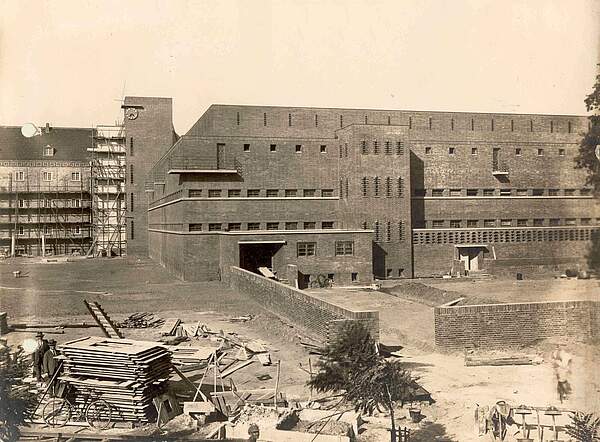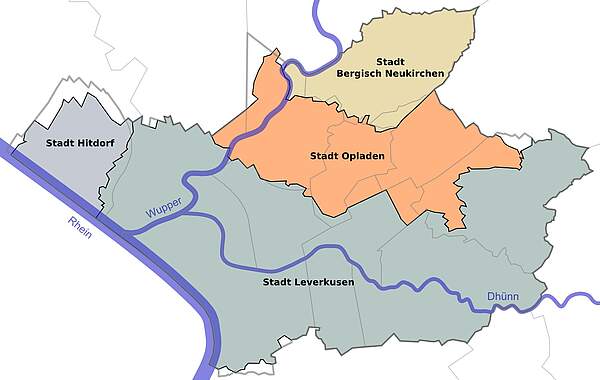Team Presentation
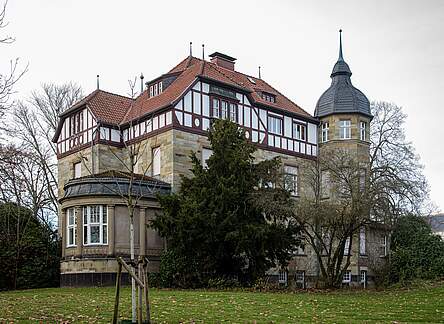
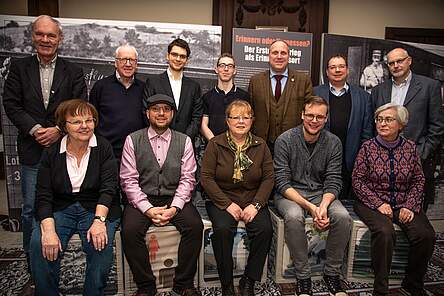
Back row from left: Manfred Heil, Ernst Küchler, Arne Buntenbach, Marvin Halfmann, Michael Gutbier, Guido von Büren, Wolfgang Hasberg.
Front row from left: Renate Blum, Christian Drach, Suzanne Arndt, Philipp Schaefer, Maria Lorenz (Photo: Borgfeldt)
The Leverkusen working group of the project "StadtRäume - UrbanSpaces" is coordinated by the Opladener Geschichtsverein von 1979 e.V. (OGV). The working group usually meets once a month in the Villa Römer, the headquarters of the OGV in the Leverkusen district of Opladen . The OGV with its chair Michael D. Gutbier is also the initiator of the international project "StaR-UrbS".
The Opladen History Society (OGV), founded in 1979 by the then 11-year-old Michael Gutbier and a few classmates, is primarily dedicated to the following goals: Promotion of education, in particular historical-political educational work in the fields of general history, regional and local history, as well promoting the care and preservation of cultural values in Leverkusen. One focus is the district town of Opladen, which was independent until 1975. The OGV maintains an association archive which includes historical photographs, newspaper articles and maps; it is open to interested parties. Every year, the OGV presents a special exhibition in the Villa Römer - House of City History. The OGV maintains partnerships with historical societies and similar institutions in Germany and abroad, especially in Leverkusen's European twin towns (Bracknell, Ljubljana, Oulu, Raciborz, Schwedt, Villeneuve d'Ascq) and with the Jülich Historical Society. The OGV publishes two series of publications: the "MONTANUS - series of publications on local and regional history in Leverkusen" (19 issues to date) and the "OGV-Kurier" with societal news and historical articles (97 issues to date). Trips, excursions and lectures round off the association's work.
The Scientific Advisory Board of the OGV provides impulses for the work of the Association. Its chairman is Prof. Dr. Wolfgang Hasberg from the University of Cologne, his deputy is Guido von Büren, chairman of the Jülich Historical Society. Together with Michael Gutbier, all three are project leaders of the "StaR-UrbS" project and coordinators of the Leverkusen project working group. The project group also includes some members of the OGV association's board . In addition, there are external people interested in history, both hobby and professional historians. Dr. Julius Leonhard, Director of the Leverkusen Municipal Archives, and Dr. Alexander Kierdorf from the "Verein Rheinische Industriekultur e.V." should be mentioned for the latter in particular.
The "Team Leverkusen" thus maintains close contacts with other institutions and organisations, in particular with the Leverkusen Municipal Archives, the Jülich Historical Society and students at the University of Cologne.
Town Presentation
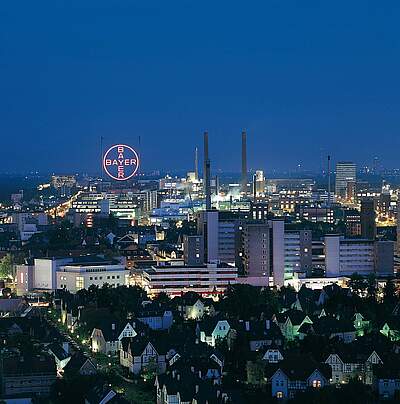
The city of Leverkusen is an administrative district-free city with a population of approximately 160,000. It is located in the west of Germany, in its most populous federal state, North Rhine-Westphalia. It borders on the city of Cologne, the fourth largest city in the state, to the southwest.
The distinctive landmark of the city of Leverkusen is the Bayer Cross [Fig. 1], the largest illuminated advertisement in the world. Visible from afar, the Bayer Cross refers to the headquarters of the chemical and pharmaceutical company Bayer, which is located in Leverkusen. Bayer AG is still by far the largest employer in Leverkusen.
A significant factor in Leverkusen's economic development was and is its location on important transport routes: On the one hand, Leverkusen is located on the Rhine and thus on one of the busiest waterways in Europe. In addition, the city is crossed by three railway lines and three motorways. At the Leverkusen motorway junction, which is geographically central to the city, two of Germany's longest motorways meet. The Leverkusen Rhine Bridge - a new bridge is currently being built right next to the dilapidated 1965 bridge - connects Leverkusen with the north of Cologne.
Leverkusen has several museums, the most important of which is the municipal Museum Morsbroich. The museum is located in a baroque palace and has specialised in contemporary art. The Villa Römer, a 19th-century industrialist's mansion, is home to the Haus der Stadtgeschichte (House of the City's History), where the three Leverkusen history societies present various changing exhibitions as well as the permanent exhibition "ZeitRäume Leverkusen". The industrial museum Freudenthaler Sensenhammer is located in a disused scythe forge and is also used as a concert and event venue.
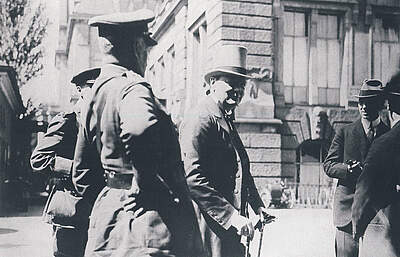
In addition, Leverkusen is known nationally and internationally as a sports city. Today, the flagship is the Bayer 04 Leverkusen football team, which plays its home games in the BayArena, centrally located in the city. Bayer 04's athletics, basketball, volleyball and handball departments have also achieved great success. The basketball players of the "Bayer Giants" are record champions of the Basketball Bundesliga, the women's handball team is the only remaining founding member of the Handball Women's Bundesliga and also the team with the most titles.
If you look at the area where the city of Leverkusen is located today, you will notice that the word "Leverkusen" did not designate a municipal unit until 1930. Until then, it was rather a place name for the headquarters of the Bayer plant and the employee dormitories located nearby. 100 years ago, the area that is now Leverkusen was structured quite differently in terms of municipal affiliation than it is today. There were four towns, Opladen, Wiesdorf (since 1920), Bergisch Neukirchen and Hitdorf, and two mayoralties, Rheindorf and Schlebusch, in the area of today's city of Leverkusen. All of these municipalities were in a process of transformation from an agrarian to an industrial society that had begun in the 19th century - with all its accompanying symptoms, such as population growth, social inequalities and tensions, which also had different effects in "Leverkusen".
Here, too, the challenges that accompanied the end of the First World War all over Germany were palpable. In Wiesdorf and Opladen there were Socialist-style workers' and soldiers' councils for a few weeks after the November Revolution in 1918. But other consequences of the First World War, such as the Spanish flu that was rampant worldwide, were also felt in the Leverkusen area. A direct consequence of the First World War was the presence of occupation troops in the area of the present-day city of Leverkusen in the course of the Allied occupation of the Rhineland. English, Scottish and New Zealand troops were stationed in Wiesdorf and Opladen, and the British occupation regiment dictated political events in what is now the city until 1926. The visit of British War Minister Winston Churchill to the Bayer factory in Leverkusen in 1919 underlined the importance of this industrial location [Fig. 2]. Here at the Bayer dye works as well as at the railway repair works, by far the largest employer in Opladen, the conversion from a wartime to a peacetime economy was a major challenge in the post-war years. This also affected the numerous women who had been drafted to work on the "home front" in the war years to replace the men fighting in the war and now had to readjust their role in post-war society again.
The economic and infrastructural development that slowly restarted in the Leverkusen area after the First World War, was slowed down by the hyperinflation in 1923. Like most municipalities in the German Reich, the towns of Opladen and Wiesdorf issued “Notgeld” (emergency money) in 1923 to keep cash in circulation in times of ever greater monetary devaluation [Fig. 3]. These emergency notes were printed with increasingly higher denominations and were initially artistically designed with historical motifs. In Germany, inflation was only brought to an end by a currency reform, so that the year 1923 can be described not only as a year of crisis, but also as a turning point.
However, the "interwar period" in Leverkusen, a changeable time full of crises and twists and turns, also had some remarkable continuities, which shall be exemplified with the help of two people in prominent positions. Both Carl Duisberg, General Director of Farbenfabriken Bayer from 1912 to 1926 and then Chairman of the Supervisory Board of I.G. Farben until his death in 1935, and Adolf Lucas, District Administrator of the district of Solingen with the district town of Opladen from 1900 to 1927, were in responsible positions in business and politics at that time. They experienced the transitory period from the Empire through war and revolution to the Weimar Republic and shaped the Leverkusen area through their professional activities [Fig. 4].
Duisberg can justifiably be considered the actual builder of the Bayer plant in Leverkusen and, as general director of Bayer, exerted considerable influence on the political, infrastructural and cultural development of Wiesdorf. In 1930, for example, he supported the merger of Wiesdorf with Schlebusch and Rheindorf to form the newly founded city of Leverkusen, not least to prevent its incorporation into Cologne, where Bayer, as one large company of several, could exert less influence than in a manageable city like Leverkusen. In the cultural sphere, Duisburg supported Bayer's gymnastics and sports clubs and the cultural offerings in the form of music, dance and drama, for which Bayer still maintains its own stage house, the "Erholungshaus", built in 1908.
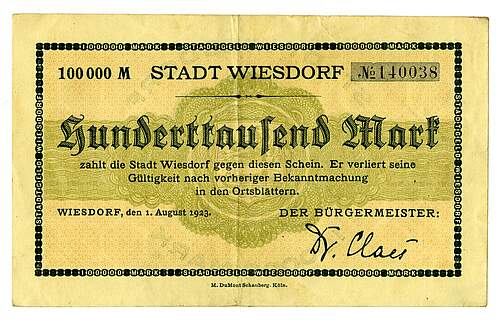
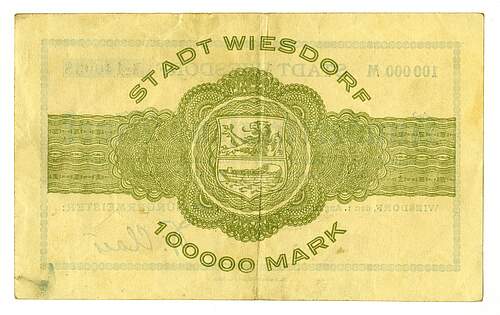
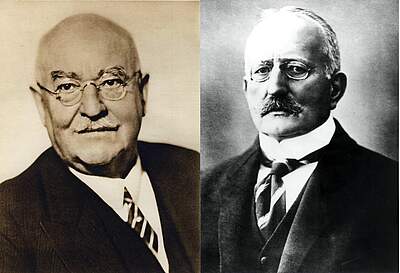
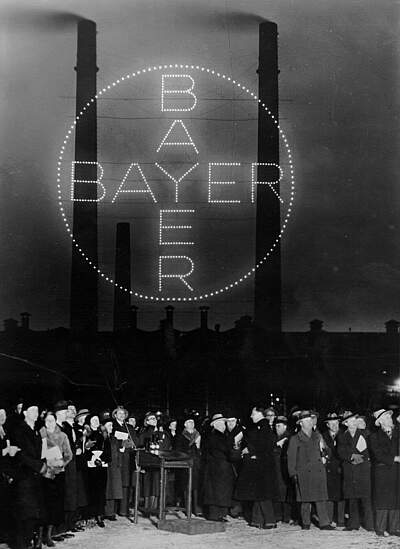
As a conservative Prussian district administrator, Adolf Lucas embodied continuity after the end of the imperial era, but he was also vehemently committed to his district, the supplying of the population and the development of infrastructure, cultural and educational facilities in the new political system. Duisberg and Lucas exchanged letters over a long period of time, from 1912 to 1935, which will be analysed as part of the UrbanSpaces project. Under Carl Duisberg, Bayer rose to become a global player, which in 1925 merged with other large chemical and pharmaceutical companies to form Interessengemeinschaft Farbenindustrie AG (I.G. Farben). In the interwar period, the aforementioned Bayer Cross, erected in 1933, was built under his responsibility [Fig. 5]. It was dismantled at the beginning of the Second World War and replaced by a somewhat smaller new building after the war.
The "interwar period" produced a whole series of new buildings and innovations in the field of urban development and infrastructure in the Leverkusen area, some of them based on plans that had already existed before the First World, War but were only then being realised. These included projects in housing development, such as the "fire brigade housing estate" built in 1922/23 by the town of Opladen, which was unique in its form of construction, as it architecturally combined flats for the firemen with the fire station and the appliance house. In Wiesdorf and later Leverkusen, the architect Wilhelm Fähler, who worked for the municipality, had a decisive influence on urban development in the "interwar period". At this time, he designed buildings in the modern, international style, such as the Carl Duisberg Grammar School [Fig. 6]. He also planned the Neuenhofsiedlung, a large housing development project of the "interwar period" in Wiesdorf. In the area of infrastructure, the expansion of road connections is significant: for example, one of Germany's first motorways was built as a bypass in Opladen from 1931.
The aim of the housing development was to boost the influx of new workers for the local economy. Accordingly, not only did the population in the Leverkusen/Opladen area grow, but also the cultural offerings of gymnastics, sports, music and singing clubs, as well as restaurants with dance halls or cinemas. Political groups that had previously played no role in the Empire, such as the socialist workers' youth, were also very popular in the Leverkusen area during the "interwar period".
One particular question being investigated in the "UrbanSapces" project is how the new constitution of the Weimar Republic was received by the local people in Leverkusen/Opladen. How did democracy establish itself locally? A closer look at an event that took place in August 1929 in the Manfurt stadium, among other places, can shed light on this: District Administrator Peter Trimborn, a Social Democrat and successor to Adolf Lucas, organised a "constitutional celebration" here to win the population over to the democratic state.
On the local political level, an important event in the "interwar period" was the aforementioned founding of the city of Leverkusen through a merger of the city of Wiesdorf with the municipalities of Rheindorf, Schlebusch and Steinbüchel on 1 April 1930. Against the background of the uncertain economic situation in the entire German Reich, there was a tendency towards land consolidation and the reorganisation of municipal units in order to thereby make local administrations more efficient and economically independent. As far as the result of this reorganisation in the Leverkusen area is concerned, the merger that was ultimately carried out was a solution to which there had been several alternatives that had been met with a high approvals from the local population. For example, there were intensive discussions about the incorporation of Wiesdorf and Schlebusch into the neighbouring metropolis of Cologne. In Schlebusch, a referendum was even held in which the inhabitants rejected such an incorporation into Cologne by a large majority. In addition to the founding of Leverkusen, the incorporation of Lützenkirchen into Opladen was also decided. From 1930 onwards, there were thus the following four towns on the territory of present-day Leverkusen, namely Leverkusen, Opladen, Bergisch Neukirchen and Hitdorf [Fig. 7]. These four municipalities were not united to form the city of Leverkusen until a further territorial reform in 1975.
